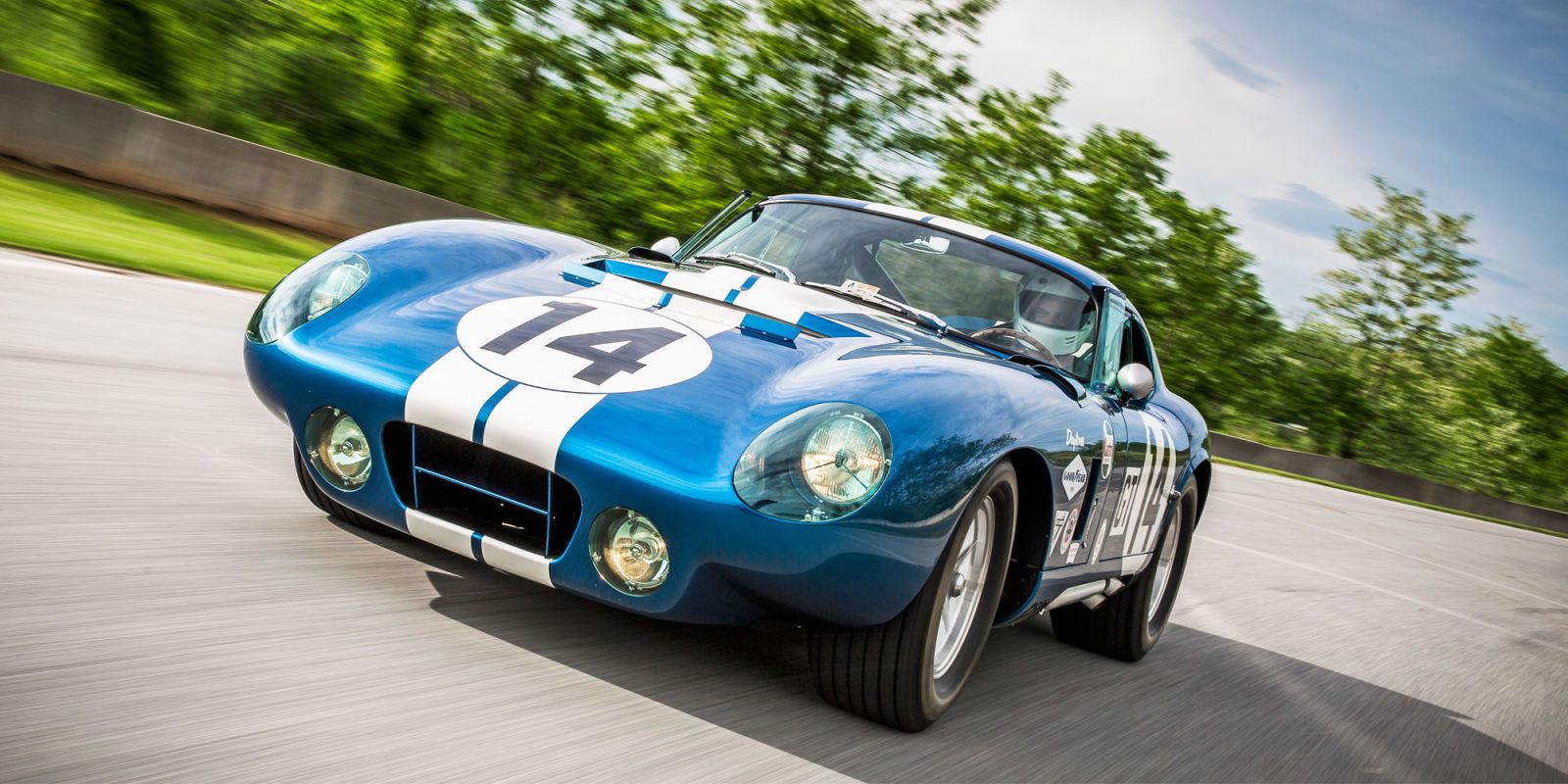Road & Track
Fifty years ago, on July 4, 1965, a car created by a handful of California hot-rodders won America its first FIA manufacturers' road-racing championship. That machine, the 1964 Shelby Cobra Daytona Coupe, was the brainchild of designer Peter Brock. From Carroll Shelby's shop in Los Angeles, it went to Daytona, Sebring, and Europe. And chiefly, it took down Ferrari, winner of 10 FIA sports-car titles in the previous 12 years.
Just six Daytona Coupes were made. The car fit into a loophole in FIA rules that allowed manufacturers to rebody an existing model for competition—the same loophole that produced the iconic Ferrari 250 GTO, the Daytona's main rival. As such, the Daytona was mechanically identical to Shelby's Cobra roadster, complete with a 289 Ford V-8.
For the 50th anniversary of the Daytona's title, we spoke with a few of the players. We hit Summit Point's 2.2-mile Shenandoah road course in West Virginia and drove a hyperaccurate, aluminum-bodied replica built by Daytona restoration guru Mike McCluskey. We brought Peter Brock. And through the following oral history and driving impressions, we tried to catch a glimpse of what made the Daytona special.
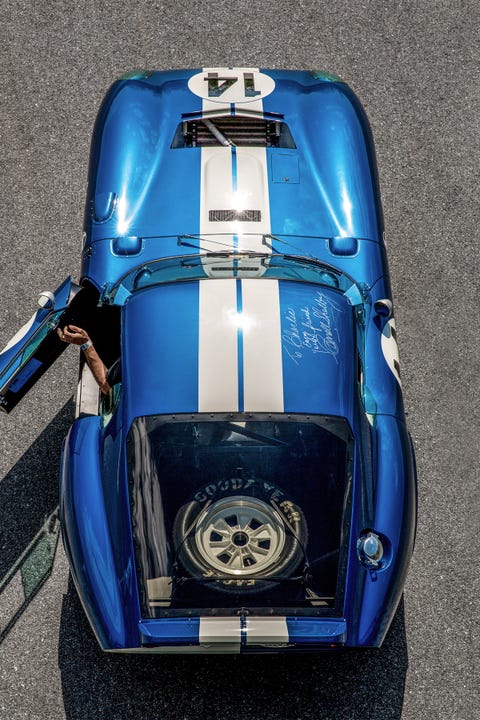
ROBERT KERIAN
CONSTRUCTION
Six Daytona Coupes were built. The body buck was assembled over the chassis of a crashed Cobra roadster, in Shelby's shop in Venice Beach, California.
CARROLL SHELBY: When I met Pete in 1961, he was living about 200 yards from Turn 9 at Riverside. I've never met a man who was so enthusiastic about automobiles. . . . For the first two years, he did practically everything at Shelby American. (From a statement made before Shelby's 2012 death.)
PETE BROCK: In 1958, I had left my design job at GM to pursue a career as a race driver in California. When Shelby offered me the job of running his School of High Performance Driving, at Riverside, in the summer of '61, it seemed like the perfect opportunity to spend time practicing what I wanted to do most.

R&T ARCHIVE
On the off days, I ran Carroll Shelby Enterprises, the bread-and-butter projects that kept us alive, while Carroll almost single-handedly created the car that was to become the Cobra. Later, I became his director of special projects— a glorified title that allowed me to design and create almost everything the public would see . . . everything that didn't fall into everyday operations.
JOHN MORTON (Shop Hand, Cobra Roadster Driver): Shelby really was an idea man; he wasn't a designer. He didn't even really profess to be—he faked it a little, you know, for publicity.
BROCK: He knew his strength was his men, not his cars. And he could be pretty oblique. One summer day in 1963, he said, "Pete, can you design a new body for the roadster that will give us more top speed?"
CHARLIE AGAPIOU (Chief Mechanic): Obviously the 289 Cobra, as a roadster, it did extremely well. It did have a lot of brute horsepower, which the Ferraris and Astons didn't have at that time.
BROCK: The roadster was devastating on U.S. tracks, which averaged about 2.5 miles per lap. In Europe, many of the straightaways were longer than an entire lap of some U.S. circuits!
BOB BONDURANT (Driver): Aerodynamically, the roadster was a boxcar. At Spa in 1964, we'd be flat out in fourth, and the GTOs and Porsche 904s would just drive around us and pull away.

R&T ARCHIVE
MORTON: Peter designed T-shirts, the Cobra emblem, stuff like that. But this was kind of his breakthrough chance, and he took it very seriously. Much more than anybody else, in the beginning.
BROCK: I sketched up a few ideas— ballpoint pen on legal pads. Nothing fancy. I'd been sketching the lines in my mind and on paper for some time. While at GM, I'd found some translations of studies on automotive aerodynamics done by Dr. Wunibald Kamm in Germany in the late 1930s. The data seemed perfectly logical—why try to dispute the laws of physics? The shapes, however, looked so strange that no manufacturer was willing to risk trying them in production.
GORDON CHANCE (Tuner): Pete was given free rein at Shelby for one simple reason—there was nobody there that could tell him what to do. And was bet- ter than he at doin' it.
MORTON: It wasn't a very big shop—five or six thousand square feet. I remember watching that car come to be. Peter running around with a pencil in his mouth, coming down to the shop and back to the offices upstairs, measuring things on a roadster.
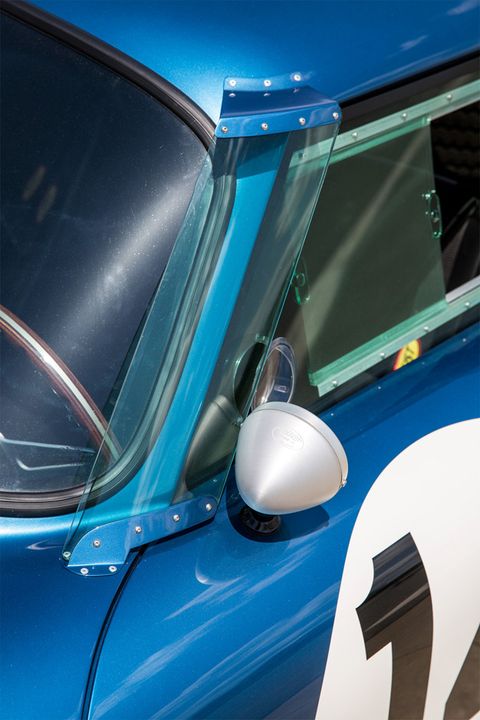
ROBERT KERIAN
BROCK: The whole Daytona concept was pretty weird—but I was convinced I was right. By today's standards, we had been in the dark ages aerodynamically. It wasn't easy to hold on to my convictions. I was working with the finest group of American racers ever in one place. Their skepticism . . .
AGAPIOU: I don't think some of the guys in the shop were very excited about it.
CHANCE: Everybody hated that f***in' car. They all hated it.
MORTON: There wasn't any sense that it was important. It seemed almost a pain in the neck that they had to go to the trouble of doing this while trying to run the roadster.
BROCK: Shelby seemed immune. Either he didn't understand what I had cre- ated, or he didn't care what anyone else thought. All he asked was, "Do you think it'll work?" Yeah, I replied. "Okay, let's build it." That was it—pure Shelby.
MORTON: There was an attitude that it was Pete's folly. Phil Remington, I remember, said he didn't think it looked like a race car.
BROCK: All the details, that was the guys on the shop floor making it work. The car was just as much designed by them as anything I drew up. I'd put down the lines, [mechanic] John Ohlsen cut them out of plywood, and that was it. We only had 90 days to build the first car, and just enough money to build six.

ROBERT KERIAN
CHANCE: The first body was formed at Cal Metal Shaping, in Los Angeles. [Shelby fabricator] Jack Lane welded it together, a couple of weeks. You've probably read about the aircraft engineer who came to the shop and told Peter everything was wrong. Famous old story. Just a load of horseshit, taking the car apart.
BROCK: Benny Howard. Racing planes in the Thirties. "If what you say were true, airplanes wouldn't fly." I kept thinking, If this guy is so smart, how come he's never heard of Kamm? His closing remarks were, "Get rid of that flat plate area at the rear. Nobody's ever made a car that went fast that looks like that."
CHANCE: Carroll normally kept his nose out of things. He was the easiest guy you'd wanna work for, because he never once came into the shop and said, "Eh, you're doing that wrong." Now, you didn't wanna bend over in front of him . . .
BROCK: Carroll and Howard left for lunch. Carroll came back after. "Do you want to change anything, Pete?"
"No, I think we're right on." Long silence.
"Carroll, have I ever let you down?"
"No, but goddammit, you better be right!"
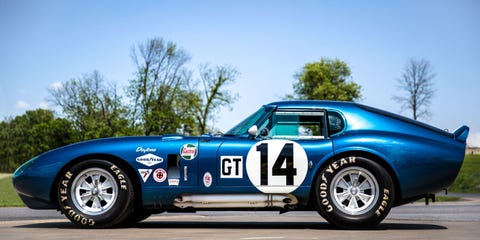
ROBERT KERIAN
SUMMIT POINT, 2015: You're immediately struck by how small it is. A GTO is feminine; this is compact but masculine, a bulldog. Like a lot of Sixties race cars, the interior is all fasteners, as if a hardware store had explosively pollinated itself in the cockpit. And the shape is more than it seems—nearly every line is a compound curve, subtle and complex. The rear tires are almost comically wide—steamrollers under that duck's back of a tail.
Shoehorning inside takes planning. There's a massive amount of space, but most of it isn't for the driver. Seat all the way back, the wheel still hits my knees. At five foot eleven and 180 pounds, I fit an open Cobra better. I fit a GT40 better. I fit a 50-gallon drum with a hole in the top better. If you sat down and designed a machine to make someone not want to do 180 mph in rainy race traffic at night, it would look an awful lot like this. Maybe more comfortable.
The interior is sheet aluminum, a roll bar made of eerily small tubing, simple Stewart Warner gauges, and a low-backed seat. That famous Ford shifter for the four-speed. Under the hood, a 289 and Webers. A dry-break coolant fitting. And narrow body tubing—drinking straws supporting aluminum thin enough to dent with a finger. —SS

R&T ARCHIVE
TESTING
Resource allocation meant the remaining five coupe bodies were constructed by Carrozzeria Gransport in Modena, Ferrari's hometown. But development occurred in California, with that first car. And Shelby's legendary competition director, Ken Miles.
MORTON: I went out with it when it was first tested, and Miles gave me a ride around Riverside. Those tests were pretty laid-back. It was very much what an amateur team would do today, as far as wearing racing suits—nobody cared. You'd just get in the car and drive it around, and come back and tell whom- ever what you thought.
AGAPIOU: Ken was an engineer when he left England, and he was brilliant at sorting cars. Everything I learned, I learned from Ken Miles.
BROCK: The fact that I didn't have complete engineering drawings didn't seem to bother him in the least.
MORTON: I used to run with him sometimes in the mornings at races. Nobody else ran back then. Even though he was older than the other drivers,he had unbelievable endurance, better than mine at 21. He was skinny as a rail, kind of a remarkable guy. But he wasn't very gregarious.
BROCK: We used the long course at Riv- erside. I asked Miles the next morning.
"It's very good," he said, "better than I expected for a first-time test."
"Yeah, but what about the handling, like up through the esses or Turn 1?"
"Look"—he was in a hurry—"there are a few small problems, but we broke our own lap record by three and a half seconds!"

ROBERT KERIAN
CHANCE: Just immediately shattered it. Depending on the book you read, it took 200 laps, and the car was a shit- box, and it took forever to fix it. That's all Shelby bullshit.
BROCK: The mechanics repositioned it, in the center of the shop, as soon as we got home. That spoke volumes. Miles had asked them to pull the differential and verify the ratio. They grinned.
"Miles doesn't believe how fast the car is going." He counted the teeth himself, then just shook his head and walked away. The coupe was running 183 mph down the back straight.
Two weeks later, we had to run 2000 kilometers at Daytona—against Ferrari.
SUMMIT POINT, 2015: The engine starts, this barking burble. RapapapaWHAPPATACRACKATA. Sitting in the seat when it lights for the first time is like firecrackers in an airplane bathroom—you jump a little, but there's nowhere to go.
I shuffle the car around for photography, in street clothes. The aluminum floor, inches from a header, leaves a shiny burn on my ankle the first time I accidentally relax my leg. And the second, and the third.
I brought a Nomex race suit. As I head off to put it on, Pete makes fun of me. Tells me to be a man, tape up my ankle. That Miles tested the thing in T-shirts.
So I grumble a little and think, Miles, you pansy. You only live once. And I click the car's little four-point harness shut and pull onto the track, and attempt to drive a given quantity of whee out of it. In a Le Mans car, surrounded by fuel and explosions and aluminum too hot to touch, in a tiny leather bucket, bare-ankled, in a T-shirt and khakis. The car comes on cam and explodes onto the front straight.
God help me, I love it. —SS
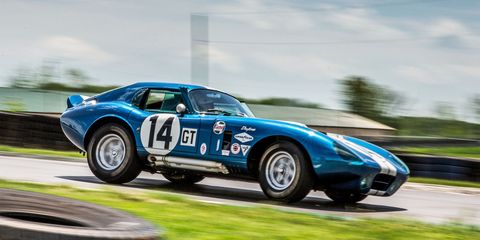
ROBERT KERIAN
RACING, 1964–65
The model was announced in January of 1964. It was called Daytona, the press release noted, "because it will probably be introduced there."
BROCK: Carroll knew Enzo Ferrari personally and did not like him.
ALLEN GRANT (Driver): One of the keys to the Cobra roadster was the fact that it was so flexible. You could keep the tires on the ground—2000 pounds, 385 hp. You could kind of throw it into the corner. The coupes were stiffer—you had to drive it more like a regular sports car.
BROCK: Ferrari forced the FIA into the Appendix J rules [allowing complete new bodies] because he knew his SWB 250 was obsolete against the Jags and Astons. He never expected the rule to be used against him. And he screamed bloody murder when the Cobra appeared with a new body.
DAN GURNEY (Driver): We knew almost from the start that the coupe was special—much better than anybody expected. It was a lot of fun to drive.
GRANT: You've got to have that God-given gift, that feeling in your butt. You don't have time to think. You're dirt-tracking, on asphalt.

ROBERT KERIAN
BROCK: During practice at Daytona in '64, Miles called to say things were going extremely well. "We're much faster than the Ferraris, Pete. Much faster." It didn't sound quite like Miles—his English reserve had evaporated.
GRANT: Keep in mind, this was an ancient, buggy-spring chassis. But once you got the hang of it . . . At Daytona, into the high bank on Turn 3, we were doing 180 mph. As hard as I tried the first time, I could not keep my foot on the throttle. But you get used to it. You don't really turn the wheel—the horizon just kicks up at a 45-degree angle. It was the same at Monza.
BONDURANT: At Monza in '65, the banking there was so rough, my eyesight started fading. At the end of the second bank, my eyes would focus again. So I just stood on it, full throttle.
GRANT: Monza's banking was concrete, poured in sections, and some had sunk. You'd hit one, and the back end would shoot out. In order to keep my foot on the throttle, I had to [brace] it at an angle. We were bouncing off the ceiling. My helmet still has a whole bunch of scratches in it.
BONDURANT: Whatever the car did, you just adapted to it anyway.

ROBERT KERIAN
GRANT: Redline in fourth gear—it felt like a small Cessna just before takeoff.
BONDURANT: At Le Mans in '64, we were leading the GT class, passing every GTO. Around 4:00 a.m. Sunday, Gurney came in, and we discovered a crack in the oil cooler. We had to lower revs by 500 rpm. We finished fourth overall and won GT. Carroll always believed that without the cooler incident, Dan and I would have won Le Mans in 1964.
BROCK: Gurney lapped at 3:56.1, the fastest GT lap ever at Le Mans.
BONDURANT: The way the French treated us, you'd have thought we won the whole race.
BROCK: Sebring in '64 was pivotal—the first win, proving we were faster than the Ferraris. Ray Geddes, our champion at Ford, convinced management to budget Europe for that year. We would have won that, except Enzo had the final race canceled. Then Geddes figured a way to keep the coupes in Europe in '65 by "lending" them to [British Ford team] Alan Mann. Mann sold all their Ford rally-team gear to finance the season.
GRANT: By that point, Ford had told Shelby to concentrate on the Ford GT40. So they sent myself and Bondurant.
BROCK: The whole Daytona project, as a design study, was finished. Mann just ran the cars as is.
CHANCE: What [caused] hurt feelings was—all of a sudden, the Cobras were yesterday's news when the GT40s [started winning]. It was just pragmatic, because Ford was payin' the bills, and the Fairlaners said, "We don't give a shit about that."
BROCK: Miles was convinced the Daytonas were faster than the GT40s, which still lacked development. He secretly built up a Daytona with GT40 brakes and engine for testing, but Remington discovered the plot. The politics . . . Ford only wanted the GT40 to win.
CHANCE: Carroll kind of floated along with the deal. That was one of the giant problems between Carroll and Peter. So now everybody's pissed, because they're dropping the Daytona like it's nothing. But in Europe in '65, they were winning hands down.

ROBERT KERIAN
SUMMIT POINT, 2015: You can chuck it. You can wrestle it, and if you're feel- ing saucy, you can tackle the car down to the corner, sloppy and free, without losing much speed. You can also drive it like the classicists, slow hands on that thin wooden wheel, and it works. Balletic. But Jesus, it's less fun.
Above all, it's honest. There's so much grip, you need the revs way up if you want to steer it with your right foot. A gentle wiggle from the back end under hard braking. If it under-steers in slow corners, it's because you did something wrong—the front suspension is basically just a leaf spring and kingpins, but it works amazingly well. The wheel gets heavy when the nose is sliding, always talking. And if the rear is going to move, the wheel gets light, and you correct, and it comes back.
The sensations are gobsmacking. The long, graceful hood, always leading the way. The setting sun gets in my eyes in a slow corner, the middle of a second-gear slide, and I instinctively pull a hand off the wheel to block it. A swirl of cockpit dust lights up in the glare. The car leaps over the hump on Shenandoah's back straight and lands a little crooked, but friendly. The engine is just torquey, hammering, long-legged Detroit.
Of course it won everything—it's a Cobra with the Cobra's main problem obliterated. After five minutes, I have zero doubt that one would carry me through a brawl at Le Mans or anywhere else.
Grabbing fourth on the front straight, I am suddenly struck by an inexplicable need to know what this car feels like at 180 mph. —SS
BONDURANT: When we got the coupes the second year, they were used cars. Carroll said, "You're the number-one driver, and you're going back over there." So I arrived at the airport, and Mann said, "I'm English, and I have the two best English drivers in the world. You'll be number three, but you'll never win."
GRANT: Bob and I got into a very, very adversarial relationship with Alan Mann.
BONDURANT: At Monza in '65, I was five seconds quicker than [Mann's] English drivers. Allen was three seconds quicker. We got a great start and were way ahead. The guys running the pits leaned over the wall—slow down!
GRANT: We were co-drivers there. And of course, we wanted to win ourselves.
BONDURANT: It was ridiculous. I was in fourth gear, downshifting to third past the pits. As soon as I was out of sight, I'd go flat out again. We ran the whole race that way. That evening, we were meeting in the bar, and [Mann driver] Jack Sears came up to me. He said, "How come you didn't wait for me?" And I said, "I beg your pardon?"
GRANT: We won at Monza.
BONDURANT: The only race I didn't win was Spa, solo, with John Whitmore solo. Whitmore and I had a good race going on, and we came up behind a guy in a Cobra roadster. Whitmore never even lifted. He hit that guy so hard. I couldn't get out of the way quick enough and damaged a front fender.
NOTE: Five coupes entered Le Mans in June of 1965; only one finished. Reims was next, followed by the season ender in Sicily. A Reims win would clinch the championship.

ROBERT KERIAN
BROCK: What I remember most about Reims were the pits. They were very old, small . . . ancient concrete.
CHANCE: All those places were like dungeons compared to today.
BROCK: The straightaway in front was a two-lane highway. The noise was incredible. The cars were well over 160 mph when they passed.
AGAPIOU: At Reims, when the Whit- more/Sears car came in with engine trouble, Alan said, "I want you guys to look like you're working on this car. I'm going to hold it in the pits until the race is almost over, then send it back out to inish." [In case Bondurant didn't, for the points.] We pulled the pan off and the rod out, because it was just hanging there. We put two bearing caps on the crank and said, "Let's run it." Alan was astounded, and the car finished the race on seven cylinders. It ran most of the race in that condition.
NOTE: When the checker fell at Reims, at 11:00 a.m. on July 4, 1965, the two Daytonas entered were the only cars in their class still running. Carroll Shelby was in America at the time, involved in other projects. Most of his team was not in France.
CHANCE: The Daytonas were yester- day's news—sort of an afterthought. And they win the world's championship! The first the United States ever won!
BROCK: The victory party was at a hotel in downtown Reims. It was sensational.

ROBERT KERIAN
1966: SHUTDOWN
The coupe's '65 season ended with little fanfare, Shelby consumed by the GT40 and Ford's obsession with beating Ferrari at Le Mans. Brock had been working on the so-called Super Coupe, a closed version of the 427 Cobra, but funding dried up, and the car went uncompleted. In 1966, the six finished coupes were offered at Shelby American's famous "garage sale," $24,000 for the lot. Like GTOs, each is now worth double-digit millions.
BROCK: Shelby was done. He didn't want anything to do with these things. He thought they were . . . That's just the way he was. Hard to explain.
CHANCE: The championship was a consequence of [Ford's] disinterest in the cars. It was just Henry's ego trip that he and Enzo were now at war. You've probably heard the story—the coupes that went to Europe were left at Alan Mann's for months. And he said, "Look, I'm gonna dump these things in the ocean if you don't come and get 'em." That's how little effort was put in.
BROCK: There wasn't time for development, because by the time that would've happened, the coupe was over and done. As a designer, I just see all the things that didn't work. If it wasn't broke, we didn't fix it. I just wanted to fix it.
CHANCE: Peter Brock, John Ohlsen, Ken Miles, and [mechanic John] "Granny" Collins, they were the guys who built that car, and they deserve all the credit in the world. You can hear the affection that Pete has for them. A handful of guys, under half a dozen, won the world manufacturers' championship for this country.
SHELBY: Ford's race car was the Ford GT, and that's where most of the money went. The Daytona Coupe was ours.
SUMMIT POINT, 2015: We can be brilliant, the human race. But also very stupid. I wouldn't trade the safety advancements of a modern competition car for all the Nomex in Europe, but there is something here that we've lost. Undeniably walked away from. Something sublime and raw that we're never getting back.
And I'd be lying if I didn't say that there is a tiny, embarrassingly Luddite part of me that wishes everything since had never happened. That this had been the final stroke of an art form, race cars never evolving further. And that they still ran Le Mans and old Spa and old Reims with loud things that were graceful and brutal and risky and thin. That it was possible for a handful of clever guys in a garage in Southern California to throw caution aside, take on that world, and win.
We got a moment, though. An instant of that light, from a bunch of hometown upstarts. Ours.
